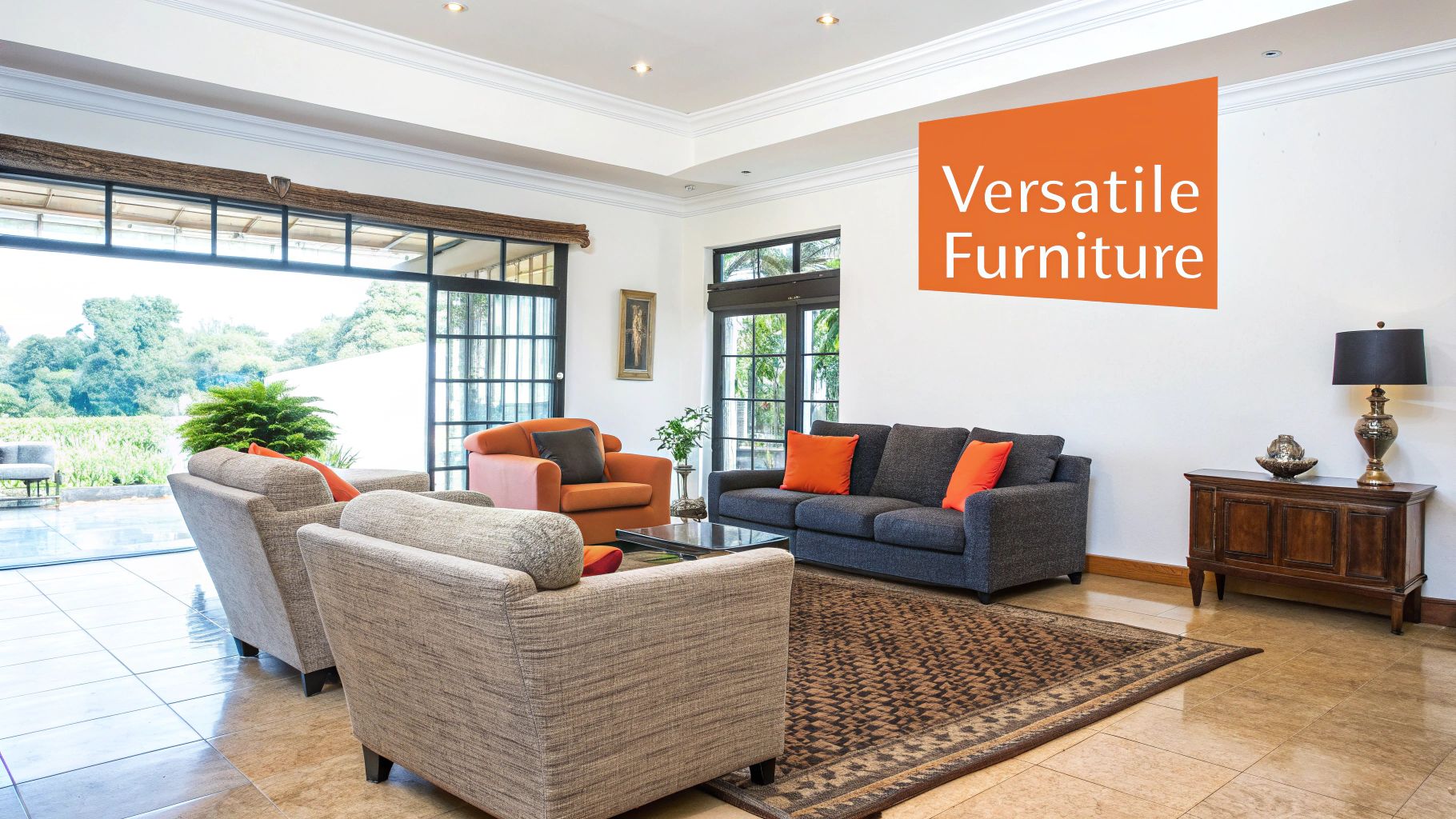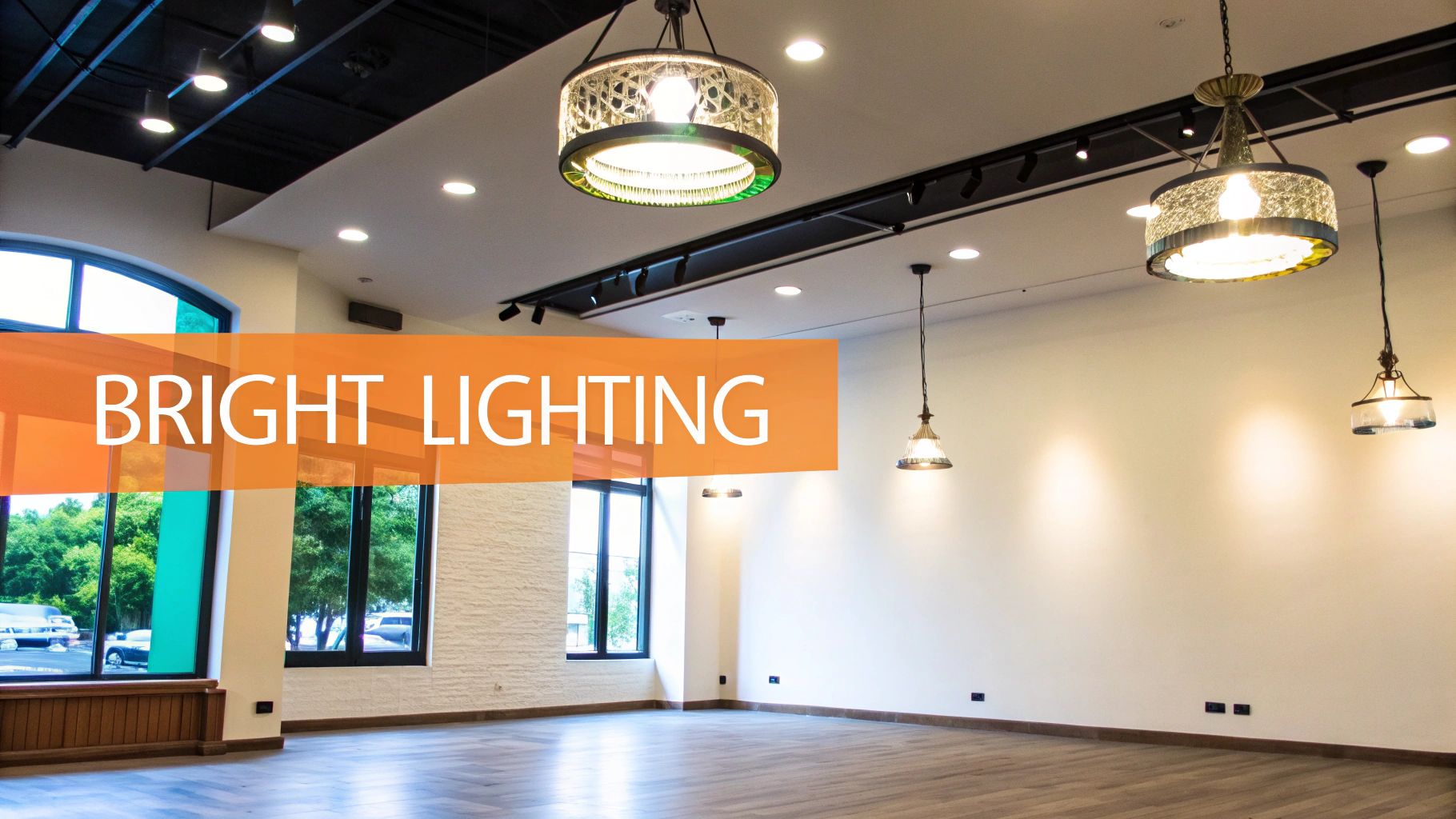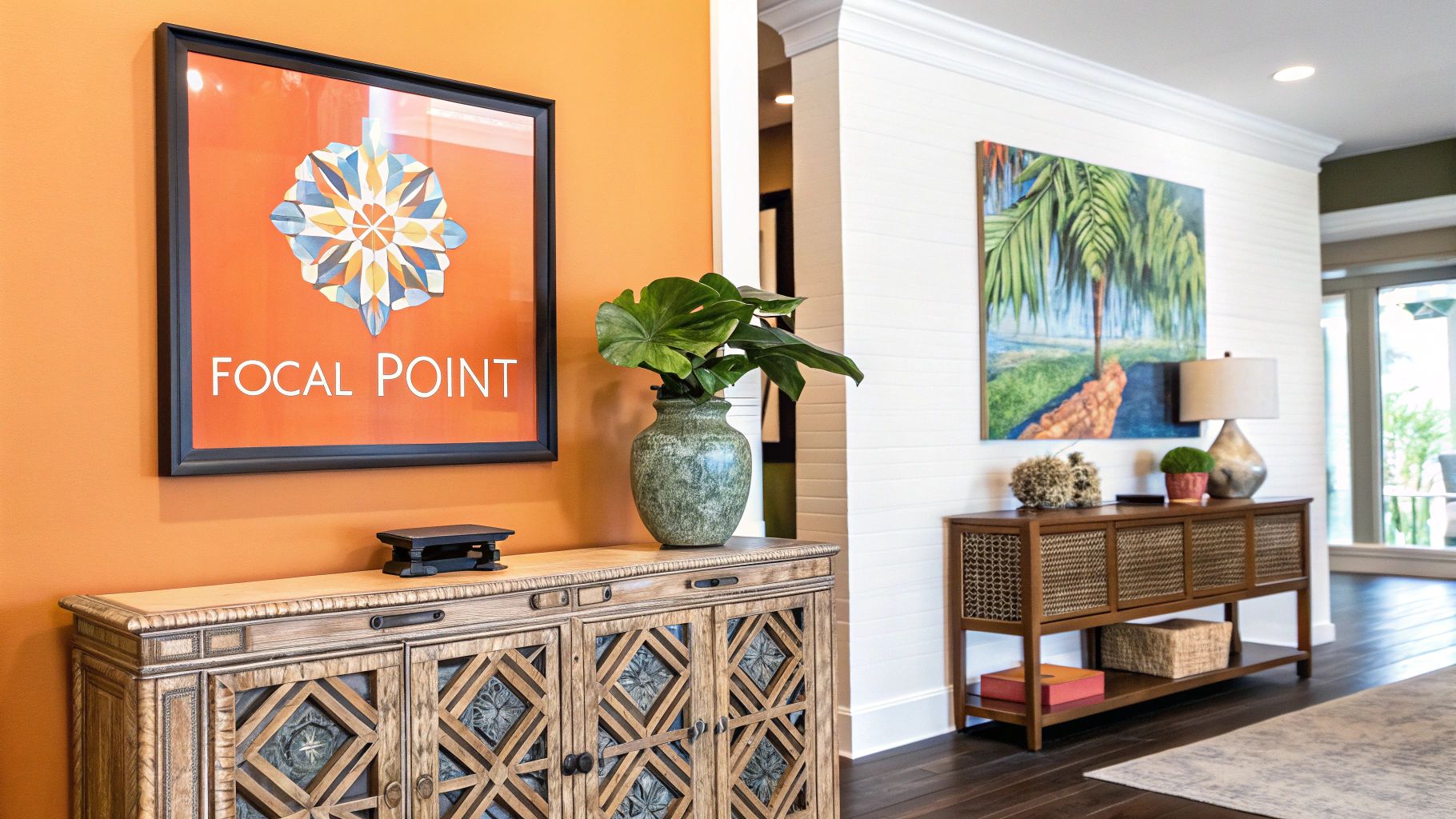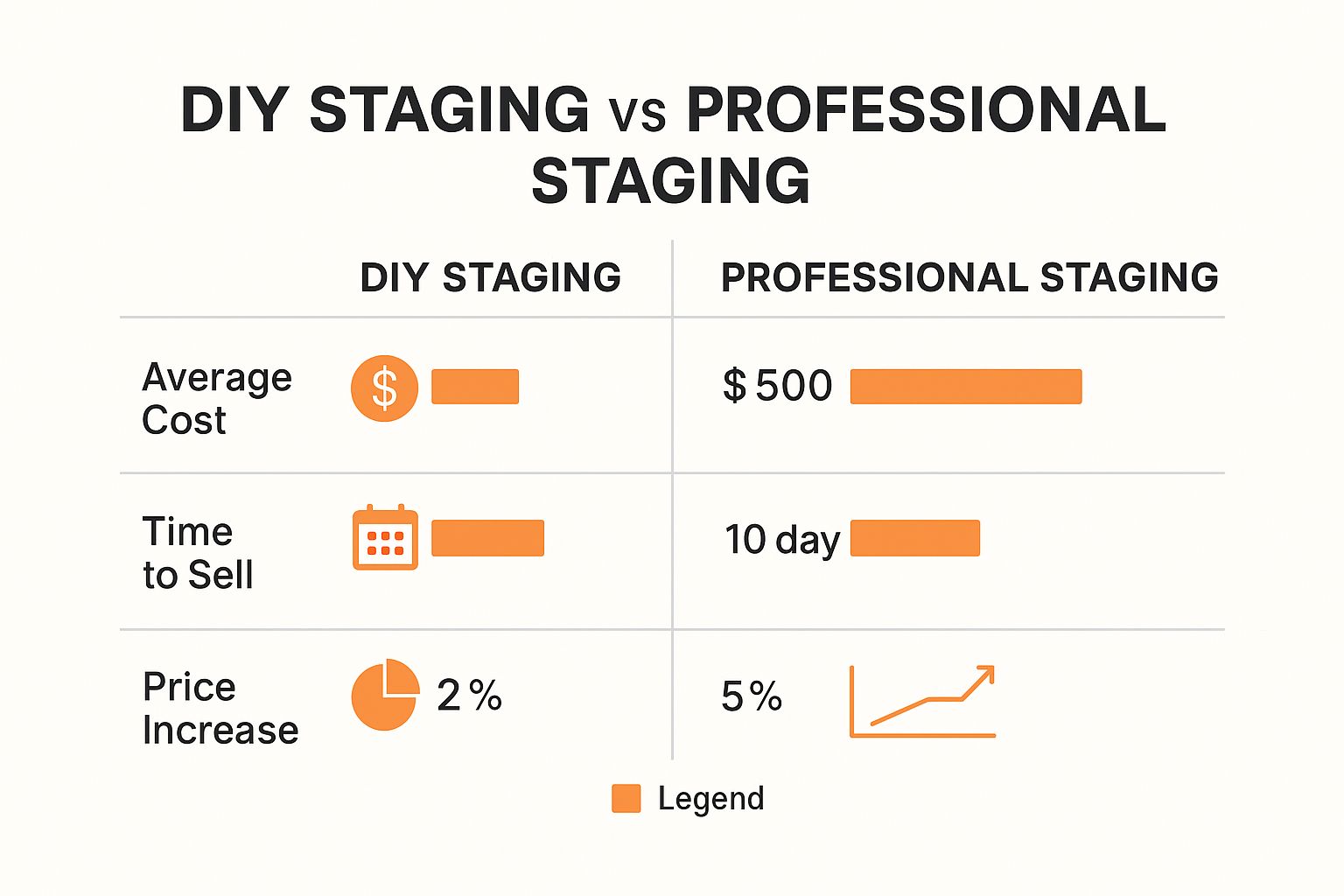How to Stage an Empty House for Sale: Tips to Sell Faster
Transform your property with our proven tips on how to stage an empty house. Learn strategies that boost buyer interest and maximize your selling price.
Why Empty Houses Struggle to Sell Without Staging
Have you ever walked into a completely empty house? The silence is the first thing you notice, followed by the way your footsteps echo off the bare walls. Every room feels like a featureless box. Ask any seasoned real estate agent, and they'll tell you this feeling isn't just awkward; it's a major roadblock to a sale. An empty house just doesn't create an emotional connection, leaving potential buyers feeling cold and unsure. It's a common myth that a "blank canvas" helps buyers see the potential, but more often than not, it just paralyzes their imagination.
The Psychological Hurdles of a Vacant Space
One of the biggest misconceptions is that an empty room automatically appears larger. In reality, the opposite is usually true. Without furniture to give the space a sense of scale, buyers have a hard time judging a room's actual size. A generous living room can feel vast and impersonal, while a cozy bedroom might seem too cramped for their furniture. Buyers can't easily visualize where their king-sized bed or sectional sofa will go, and they start to assume it won't fit, creating doubt where there shouldn't be any.
On top of that, a vacant home puts every minor imperfection on full display. When there isn't a beautiful rug or a well-placed armchair to draw the eye, buyers will immediately spot the tiny scuff on the baseboard, the small crack in the drywall, or that one dated light fixture. Instead of admiring the home's potential, their attention gets pulled toward a mental checklist of repairs and updates, which can be a huge turn-off. Good staging cleverly guides their focus to the property's best attributes.
From Cold and Echoing to Warm and Welcoming
The real challenge with selling an empty house is its complete lack of personality. It feels more like a sterile holding area than a home, making it almost impossible for buyers to picture themselves celebrating holidays with family or enjoying a quiet morning with coffee. This is where staging works its magic—it transforms a cold, empty shell into a story of a life that could be theirs. It's all about creating an atmosphere that feels warm and inviting from the moment they step through the door.
This isn't just a gut feeling; it's backed by solid data. Successful staging helps buyers make that critical leap from just viewing a property to actually seeing it as their future home. Research shows that a staggering 86% of buyers find it easier to visualize themselves living in a staged property. In fact, over 41% of top agents believe that vacant homes see the most significant benefits from staging, with some properties selling for 5% to 23% more than their non-staged counterparts. You can explore more compelling home staging data here.
Ultimately, knowing how to stage an empty house for sale is about turning these psychological challenges into powerful selling points. By defining each space and adding warmth, you give buyers the context they desperately need to fall in love with the property. You're not just selling rooms; you're selling a future. For more specific, actionable ideas on furniture placement and decor, be sure to check out our comprehensive home staging tips .
Smart Staging Budgets That Actually Work

Let's talk about the money. Staging a home effectively doesn't mean you have to empty your bank account, but it does require some smart planning. The biggest mistake I see is people spending money on things that look nice but don't actually influence buyers.
Think of your staging budget as a marketing tool, not just an expense. The goal is to treat every dollar as a calculated investment, focusing on what delivers the highest return by creating an irresistible emotional pull for potential buyers.
Prioritizing Your Staging Investment
Not all rooms carry the same weight in a buyer's mind. To get the most bang for your buck, you need to focus on the "money rooms": the living room, the primary bedroom, and the kitchen.
These are the areas where people spend the most time and truly imagine their lives unfolding—hosting parties, relaxing after a long day, or cooking family meals. When you concentrate your budget on these key spaces, you make a powerful first impression that sticks with them as they tour the rest of the house.
The numbers really back this up. While professional staging typically costs between .75% to 3% of a home's listing price, the return is impressive. According to industry data, about half of real estate agents see staging increase a home's sale price by 1% to 10%. Even better, it helps sell the home much faster. A well-staged property can sell up to 73% faster, going under contract in about 23 days compared to 184 days for a non-staged home. You can discover more home staging ROI statistics to see the full picture.
To see how this plays out in the real world, let's look at some budget examples across different home values.
Staging Budget Breakdown by Home Value
- Comparison of staging costs and expected ROI across different price ranges
| Home Value Range | Staging Budget (0.75-3%) | Expected ROI | Typical Timeline Reduction |
|---|---|---|---|
| $300,000 | $2,250 - $9,000 | $3,000 - $30,000 | Sells weeks to months faster |
| $500,000 | $3,750 - $15,000 | $5,000 - $50,000 | Significantly reduces holding costs |
| $750,000 | $5,625 - $22,500 | $7,500 - $75,000 | Attracts more serious offers quickly |
| $1,000,000+ | $7,500 - $30,000+ | $10,000 - $100,000+ | Creates a competitive edge in a crowded market |
As you can see, the potential return often far outweighs the initial cost. This is especially true when you factor in the money saved on mortgage payments, taxes, and utilities by selling the home faster.
Getting Creative with Sourcing and Strategy
Once you've decided where to focus, it's time to get resourceful. You don't need to go out and buy all-new furniture—in fact, you probably shouldn't. The smartest move for big-ticket items is furniture rental, which lets you use stylish, modern pieces without the hefty price tag.
Focus your rental budget on the "anchor" pieces that define a room:
- A neutral-toned sofa and a coffee table for the living room.
- A bed complete with a headboard and nightstands for the primary bedroom.
- A simple dining table and chairs to clearly define the eating area.
For everything else, think lean. A DIY approach to accessorizing can look fantastic without seeming amateur. Find unique decor and artwork at budget-friendly stores or by going thrifting. Borrowing a tasteful area rug from a friend or using high-quality faux plants can add instant warmth and style.
This mix of professional rentals and savvy sourcing is the secret to knowing how to stage an empty house for sale on a realistic budget. It's all about creating an unforgettable impression, not furnishing a complete home.
Creating Living Spaces That Sell Dreams

The living room is often the first big space buyers see, and it's where they'll decide whether to fall in love with a house or just move on. When you're figuring out how to stage an empty house for sale, think of this room as your main stage. It's your best chance to create a feeling of comfort, possibility, and a life they can aspire to.
The Psychology of a Perfectly Arranged Room
Arranging furniture isn't just about filling up an empty room; it's about crafting an experience. Your primary goal should be to create conversational groupings that feel open and welcoming. Instead of pushing your sofa against the far wall, try "floating" it in the middle of the room with a couple of chairs opposite, all anchored by a nice area rug. This one move can create an inviting social zone that makes buyers want to sit down and stay awhile.
Think about a common problem layout, like a long and narrow living room. Too many people fall into the "bowling alley" trap, lining up furniture along the walls. A much better approach is to break the space into two distinct areas. You could have a main seating area around a focal point and a cozy reading nook near a window. This shows off the room's versatility and helps buyers imagine using every last inch of it.
Choosing a Palette That Sells
When it comes to color, you have to find that sweet spot between personality and broad appeal. The safest bet is to start with a neutral foundation using warm grays, soft beiges, or classic off-whites. Top real estate agents often recommend colors like Agreeable Gray from Sherwin-Williams because it provides a calm, beautiful backdrop that looks amazing in photos and allows buyers to easily picture their own belongings in the space.
Once you have your neutral base, you can bring in some character with carefully chosen accessories:
- Throw pillows and blankets: These are perfect for adding pops of color, like a trendy dusty blue or sage green.
- Artwork: A single large, abstract painting can serve as a stunning focal point without being overly personal.
- Area Rugs: A rug with a subtle pattern can pull the entire room's color scheme together.
Lighting and Accessories That Add Warmth
Good lighting is absolutely essential. An empty house can feel cold and uninviting, especially under a single, harsh overhead light. You can build a warm and inviting atmosphere by layering light at different levels. Add a stylish floor lamp in a corner, a table lamp on an end table, and maybe some small accent lighting on a bookshelf. This makes the room feel much cozier and gives it depth. Always opt for warm-toned LED bulbs to get the most flattering glow.
Accessories are the final touch that makes a staged room feel like a real home. The secret is to be intentional and minimalist. A few coffee table books, a simple vase with some greenery, or a textured throw blanket draped over a chair is all you need. If you're staging on a budget, decluttering is your first step. Using affordable storage solutions can help you clear the decks efficiently. This creates that clean, curated look that tells a story of a sophisticated life that every buyer wants a piece of.
Bedroom Staging That Feels Like Sanctuary

While living rooms are for entertaining, the bedroom is where buyers need to feel a true, personal connection. This isn't just another room with four walls; it's a private retreat where they'll begin and end their days. When you're figuring out how to stage an empty house for sale, turning the primary bedroom into a peaceful sanctuary is one of your most important tasks.
Creating a Hotel-Like Atmosphere
The best way to create a dreamy bedroom is to make the bed the absolute star of the show. Go for crisp, all-white or light neutral bedding to give it a luxurious, hotel-inspired vibe. Layering is everything here: think a fluffy duvet, a quilt folded neatly at the foot of the bed, and a few well-chosen decorative pillows. This combination adds inviting texture and makes buyers want to dive right in.
Symmetry is also your secret weapon for creating a sense of calm and order. A bed with a solid headboard is a must, framed by two matching nightstands and lamps. This simple setup makes the room feel balanced and thoughtfully designed. If you've got the space, adding a single armchair to a corner creates an instant reading nook, painting a picture of a comfortable and relaxing lifestyle.
Maximizing Space and Functionality
How you arrange the furniture can make or break the room's flow. Always try to place the bed on the wall opposite the door. It will be the first thing buyers see, creating a powerful focal point that welcomes them in. For smaller bedrooms, resist the urge to use a king-sized bed; a queen will make the room feel much more spacious and open. It's a small change that shows buyers you've been considerate about space planning.
Storage is a huge selling point in any bedroom. Instead of stuffing the closet full of items, leave it about 50% empty and hang everything on matching hangers. This simple trick showcases its full potential without looking cluttered. You can see how well these principles work, even in challenging rooms, in these inspiring home staging examples .
Finally, don't overlook the finishing touches. The lighting should be soft and layered—rely on bedside lamps for a warm glow instead of a single, harsh overhead light. Keep the decor minimal and impersonal. A small stack of books on a nightstand, a simple plant, or a textured tray is often all you need. The goal is to sell the dream of a peaceful escape, convincing buyers that this is the perfect place to unwind.
Kitchen And Bathroom Magic That Closes Deals
Let's talk about the two rooms that can make or break a sale: the kitchen and the bathroom. While buyers might daydream about future parties in the living room, they get serious when they step into these spaces. They'll be opening cabinets and picturing their daily routine, like making coffee on a hectic morning. Getting these high-stakes rooms staged perfectly is absolutely essential.
Styling the Kitchen for Daily Life
The kitchen should feel like the vibrant, beating heart of the home. A common mistake is clearing everything off the counters, which can leave the room feeling sterile. Instead, you want to strategically style them to tell a story of a happy, functional life. Try creating a small coffee station with an attractive machine, a couple of mugs, and a little jar of beans. A wooden cutting board topped with a bowl of fresh green apples or lemons adds a fantastic pop of color and a healthy vibe.
This approach shows buyers the space is ready for daily life without feeling cluttered. When you're staging an empty house, you want to hint at life without any personal items. A great tip is to open one or two upper cabinet doors to reveal neatly stacked, matching white dishes. It's a simple move that showcases ample, organized storage and reinforces the idea of a well-cared-for home.
Creating a Spa-Like Bathroom Retreat
In the bathroom, the goal is to create a serene escape. You want buyers to walk in and feel a wave of calm, as if they've entered their own personal spa. The quickest way to achieve this feeling is through textiles. I always recommend you invest in a set of new, fluffy white towels. Don't just hang them; roll a few and place them in a wicker basket, and then fold another one neatly over the towel rack.
It's really the small details that make the space feel special.
- Place a small tray on the vanity holding a nice hand soap dispenser and a simple bottle of lotion.
- Add a touch of green with a small, humidity-loving plant like an orchid or even a high-quality faux succulent.
- Make sure the mirror is sparkling and the lighting is bright but flattering.
These little touches transform a bathroom from a utility room into a personal retreat.
These intentional choices are incredibly effective because they help buyers connect with the space on an emotional level. The data on home staging is pretty compelling. A staggering 83% of buyers' agents say staging makes it easier for a buyer to visualize a property as their future home. With 40% of buyers more willing to visit a staged home they see online, that visualization leads directly to more showings. Beyond that, over 65% of realtors believe staging helps a house sell for more, with many sellers seeing a return of 5% to 15% over their asking price. You can discover the full impact of staging in this report from the National Association of Realtors. These high-impact rooms are where knowing how to stage an empty house for sale really pays off.
Virtual Staging Technology That Transforms Marketing
Imagine showing potential buyers a beautifully furnished home without ever renting a single piece of furniture. That's the magic of virtual staging. This method uses digital tools to add stylish furniture and decor to photos of an empty house. It's a game-changing tactic when you're figuring out how to stage an empty house for sale, creating eye-catching visuals that capture attention online, where most buyers begin their search.
The Power of AI in Home Staging
Modern staging tools go way beyond just adding a digital couch. AI-powered platforms like Pedra can automatically adjust lighting, fix the photo's perspective, and even clear out clutter from a room with a single click. The interface is designed to be incredibly straightforward.

As you can see, an agent with zero technical background can turn a picture of a vacant room into a powerful marketing asset in just a few minutes.
With AI, you can even create multiple design styles for the same room. Show one version with a clean, modern aesthetic and another with a cozy, farmhouse feel. This showcases a home's flexibility in a way that physical staging just can't match. You can learn more about the virtual home staging process and see some of these impressive transformations for yourself.
To better understand your options, let's compare virtual staging directly with the traditional physical approach. Each has its place, and knowing the differences helps you decide where to invest your budget for the best return.
Virtual vs Physical Staging Comparison
- Analysis of costs, benefits, and best use cases for different staging approaches
| Staging Method | Average Cost | Timeline | Best For | Buyer Impact |
|---|---|---|---|---|
| Virtual Staging | $20 - $100 per photo | 1-2 business days | Vacant homes, online listings, showing a room's potential | High online appeal; helps buyers visualize the space before visiting. |
| Physical Staging | $500 - $6,000+ per month | 1-3 weeks | High-end properties, creating an immersive in-person experience | Strong emotional connection during tours; helps justify the asking price. |
As the table shows, virtual staging is a fast and affordable way to make a big impact online, while physical staging excels at creating an unforgettable in-person tour.
Blending Virtual and Physical Staging
Often, the smartest strategy is a hybrid one. Use virtual staging to furnish every room for your online listing. This creates a complete and attractive visual package that gets people excited to book a showing. Then, you can focus your physical staging budget on the "money rooms"—typically the living room and kitchen.
When buyers walk through the door, the most important spaces will live up to the expectations set by your online photos. Even small real-world touches can go a long way. As these great kitchen makeover tips show, a fresh coat of paint or new cabinet hardware provides real value that works alongside your digital presentation.
Finally, transparency is key. Always add a small note, like "Virtually Staged," to your edited photos. Honesty builds trust and manages buyer expectations, preventing any disappointment during the actual tour. Your goal is to get them interested enough to visit; the home's natural charm, helped by your strategic staging, will handle the rest.
Your Complete Staging Success Plan
Now that you have your visual strategy ready, it's time to roll up your sleeves. This is how you turn an empty house into a must-see property and make sure every bit of effort pays off with a quicker, more profitable sale.
Your Staging Timeline and Checklist
To keep things moving without any last-minute chaos, it helps to think about your staging project in a few key phases. This simple timeline will help you get the property ready for its big debut.
- Laying the Groundwork: Start with the essentials: a top-to-bottom deep clean, clearing out any leftover clutter, and tackling those small repairs you've been putting off. This is also your chance to lay down a fresh coat of neutral paint. Think of it as creating the perfect blank canvas for your design.
- Bringing in Furniture and Defining Flow: Next, it's time to bring in the big pieces. Focus on the high-impact areas like the living room, primary bedroom, and dining space. Get your furniture rentals finalized and schedule the delivery so you have the core elements in place to build around.
- Adding the Finishing Touches: Now for the fun part—making it feel like a home. This is when you bring in the personality with accessories, artwork, cozy rugs, and warm lighting. Once everything is just right, get your professional photographer booked to capture the magic.
Coordinating for a Flawless Launch
All that hard work pays off when it's time to launch. Work closely with your real estate agent and photographer to make sure you capture the home at its absolute best. Once you have those incredible photos, it's time to get them out there.
Social media is a huge part of this. Using effective pin creator tools can help you design beautiful posts for platforms like Pinterest, showing off your staged rooms and getting more potential buyers interested in your listing.
Maintaining the Look
Don't let your hard work go to waste after the photoshoot! Every showing counts. Keep a simple "refresh" checklist handy: fluff the pillows, wipe down the counters, and turn on all the lights to create a welcoming glow for every visitor.
Sticking to a plan like this takes work, but getting stunning photos shouldn't add to the stress. ** Pedra offers a one-click way to elevate your images, from virtual staging to putting the final polish on your professional shots. ** It's the perfect partner to make all your physical staging efforts shine online. Try Pedra today and create a listing that buyers won't forget.

Related Posts
A Guide to Colored Floor Plans in Real Estate
Discover how colored floor plans can transform your real estate listings. Learn why they work, how t...
6 Floor plans for realtors You Should Know
Discover the top 6 floor plans for realtors strategies and tips. Complete guide with actionable insi...
How to Create a Virtual Tour for Real Estate
Learn how to create a virtual tour that sells properties. Our guide offers practical advice for capt...